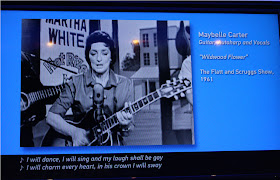My wife and I last week spent time on the Blue Ridge Parkway, a 469-mile scenic road along the spine of the eastern Appalachians in the states of North Carolina and Virginia. We did not set out to drive the whole parkway, especially wanting to avoid the congestion of the approach to the southern terminus at Cherokee, NC. So we spent our first night in Waynesville, NC, and started our parkway ride near there.
The trip got off to a good start when we walked out of our hotel room to the view above. How can you be in a bad mood when your day starts like that?
We had hoped for good color, and we got it! This large maple was absolutely on fire! You can judge the size of the tree by our car in the picture. (By the way, these pictures ARE NOT enhanced in any manner!)
The Blue Ridge Parkway was begun in 1935, another of the New Deal's projects to put Americans back to work during the depression. Construction long outlasted the depression, however. The last section was opened in 1987 with the completion of the Linn Cove Viaduct. There will be more about the viaduct later.
There are 25 tunnels in North Carolina and one in Virginia. Some are short, more like an underpass than an honest tunnel. Others are longer and require turning on headlights and taking off sunglasses to successfully make your way through them. Since I wear prescription sunglasses, one stretch was particularly annoying since I had to change glasses every few minutes. (That's a terribly trivial thing to complain about, isn't it!)
But the rewards were always waiting just beyond the tunnel.
I haven't found any data on what it cost to build the parkway, but I'm sure it was very expensive. During the 3 days we spent on the parkway we saw thousands of people, riding in cars or on motorcycles; buying food, souvenirs and gasoline along the way; and staying in resorts, cabins, campgrounds, and hotels. The Parkway is a 469-mile-long economic engine that supports both private businesses and, through taxes, local governments. The American people are getting a great return on their investment!
Please come back tomorrow; there will be more.



















































